Training In Bloodborne Pathogens
If your job demands that you come in contact with blood, the Occupational Safety and Health Administration (OSHA) requires that you become trained in bloodborne pathogens. Our blog post this week is about Bloodborne Pathogen Training.





